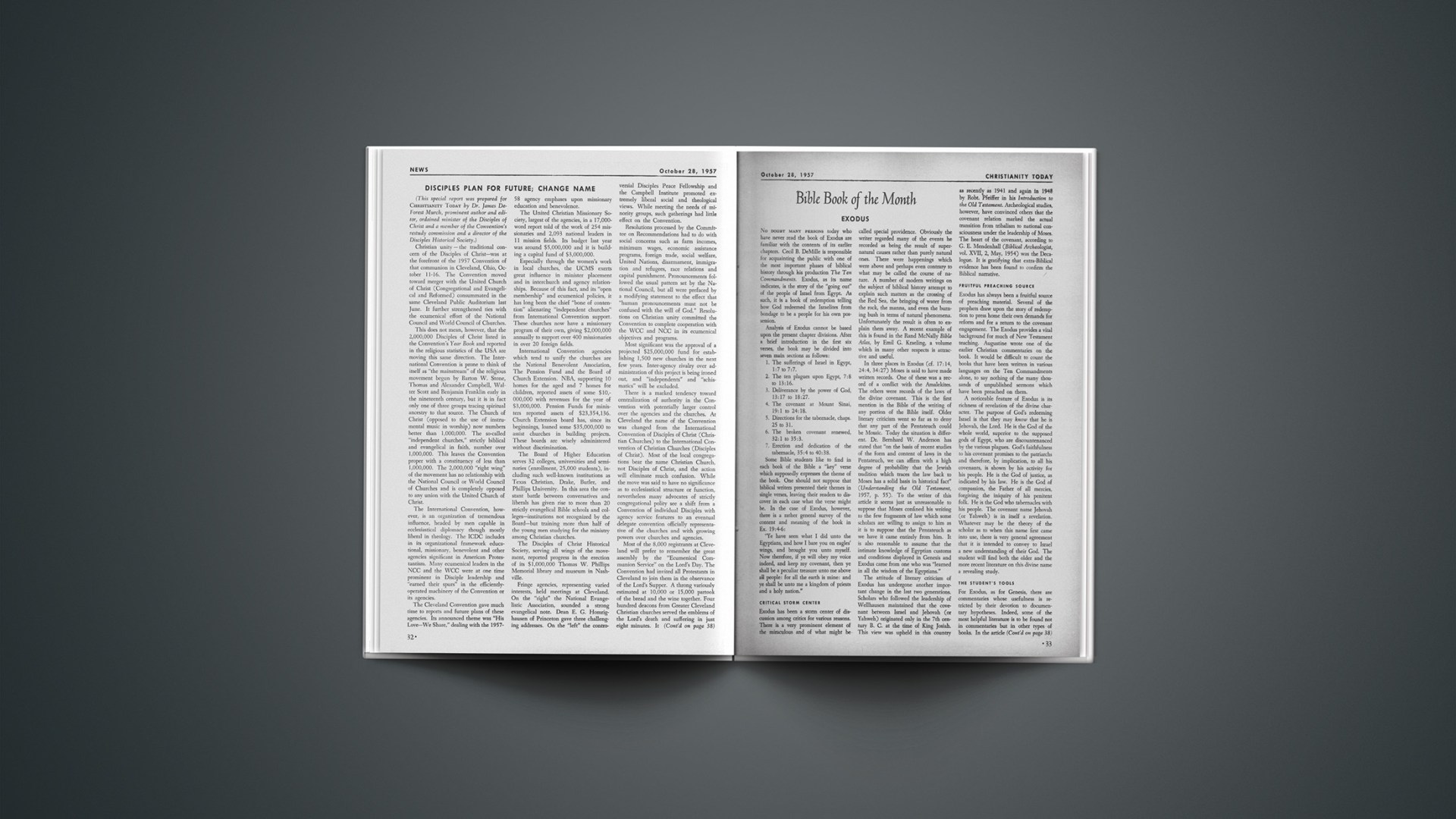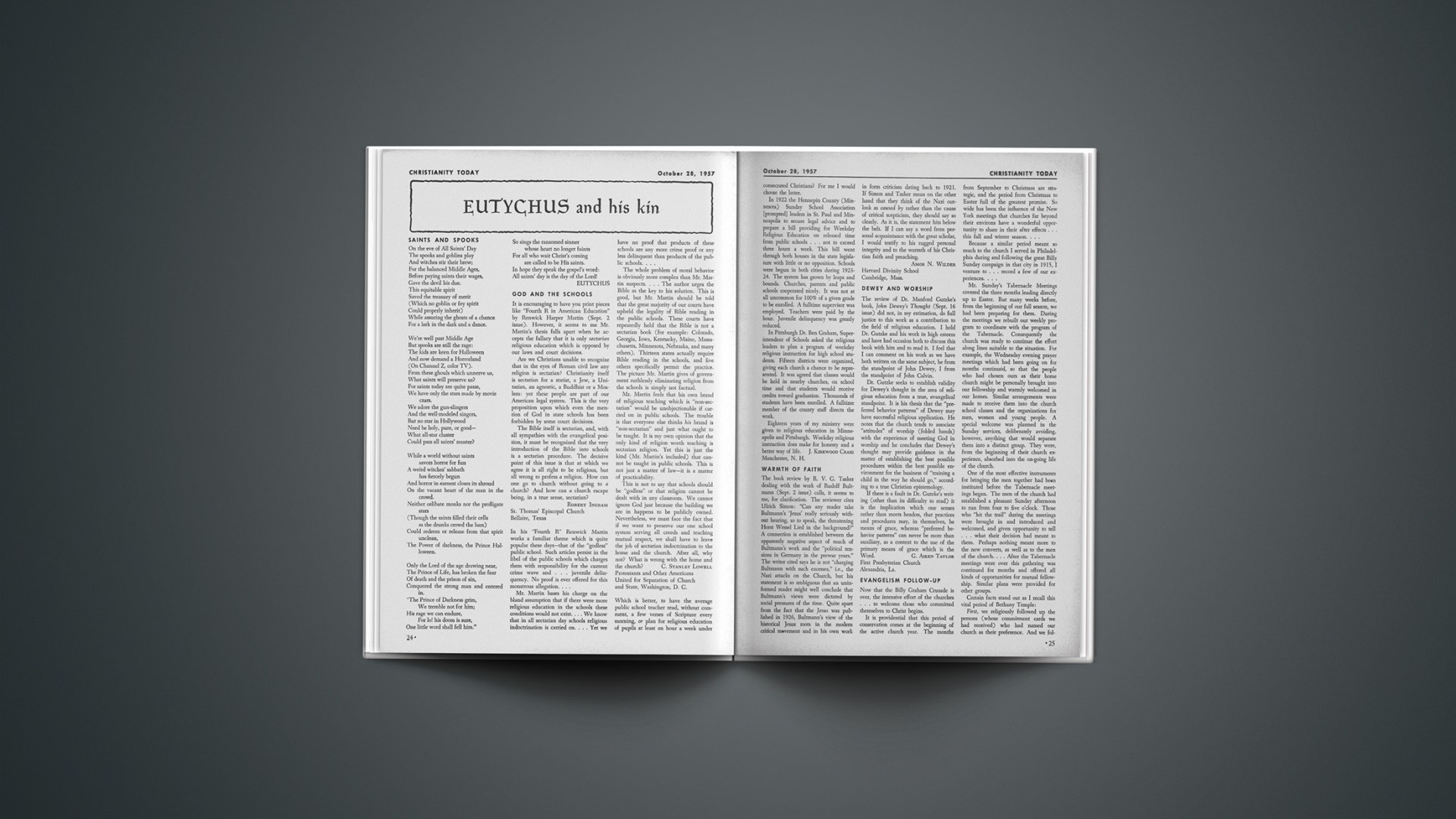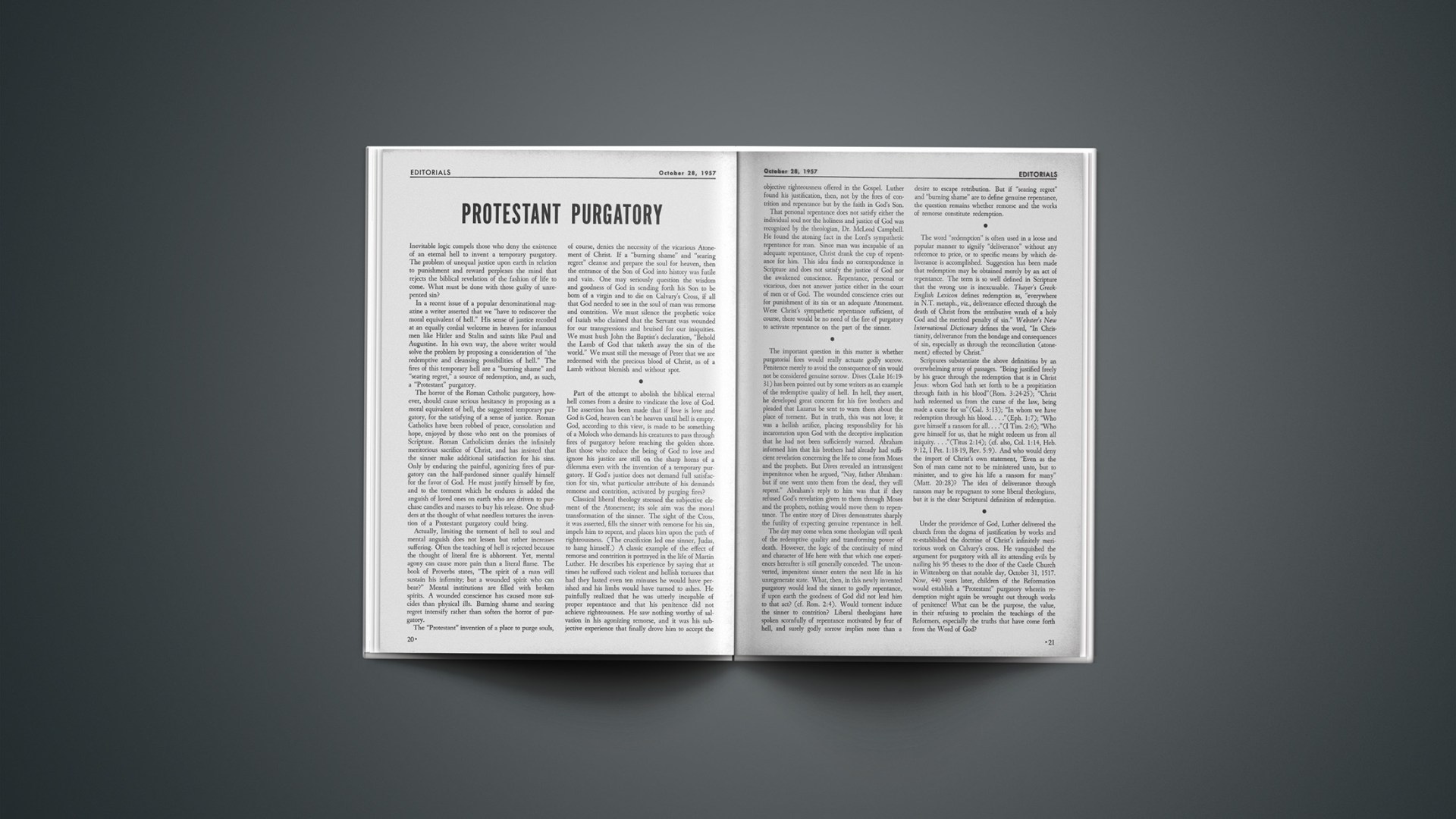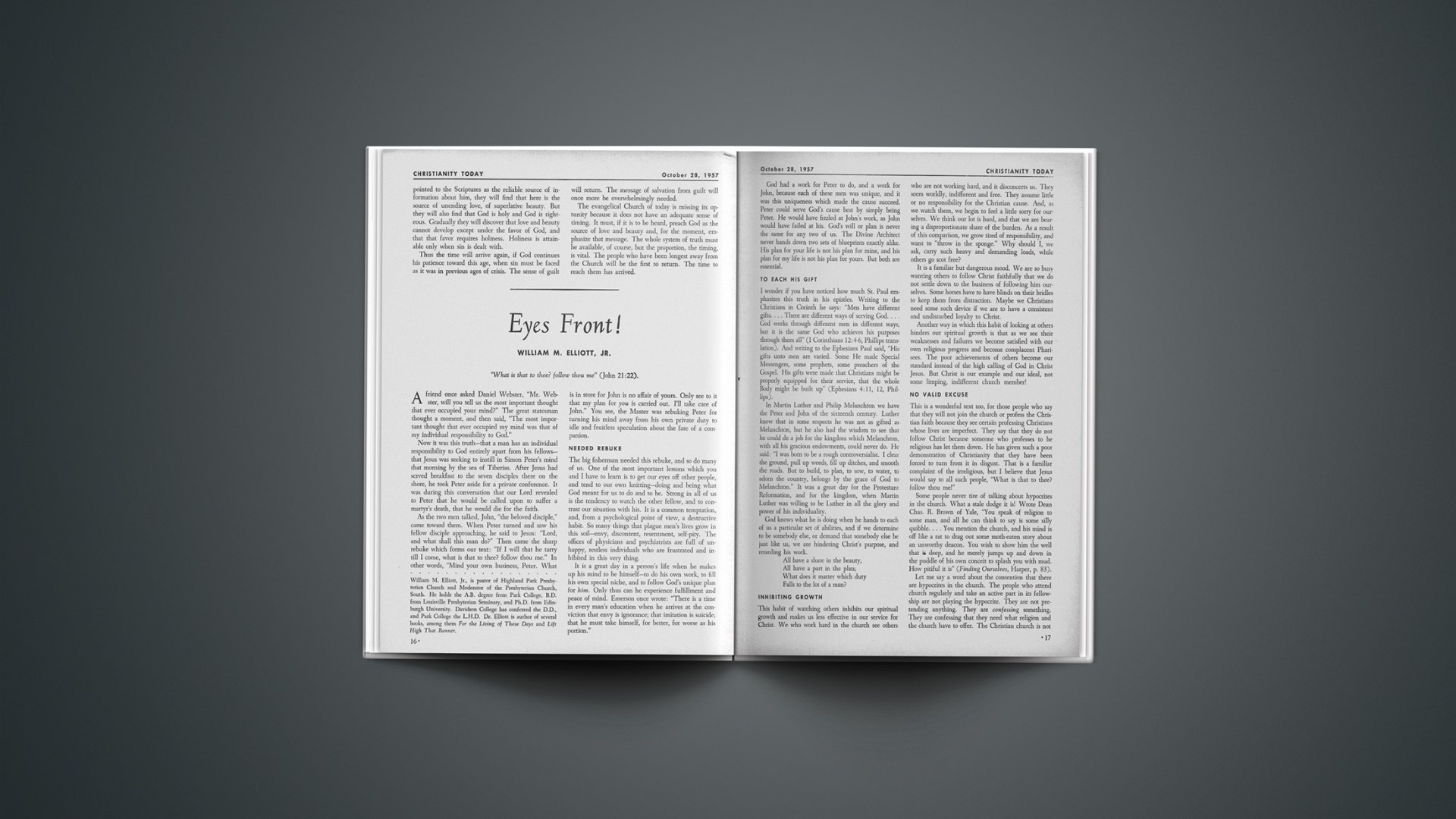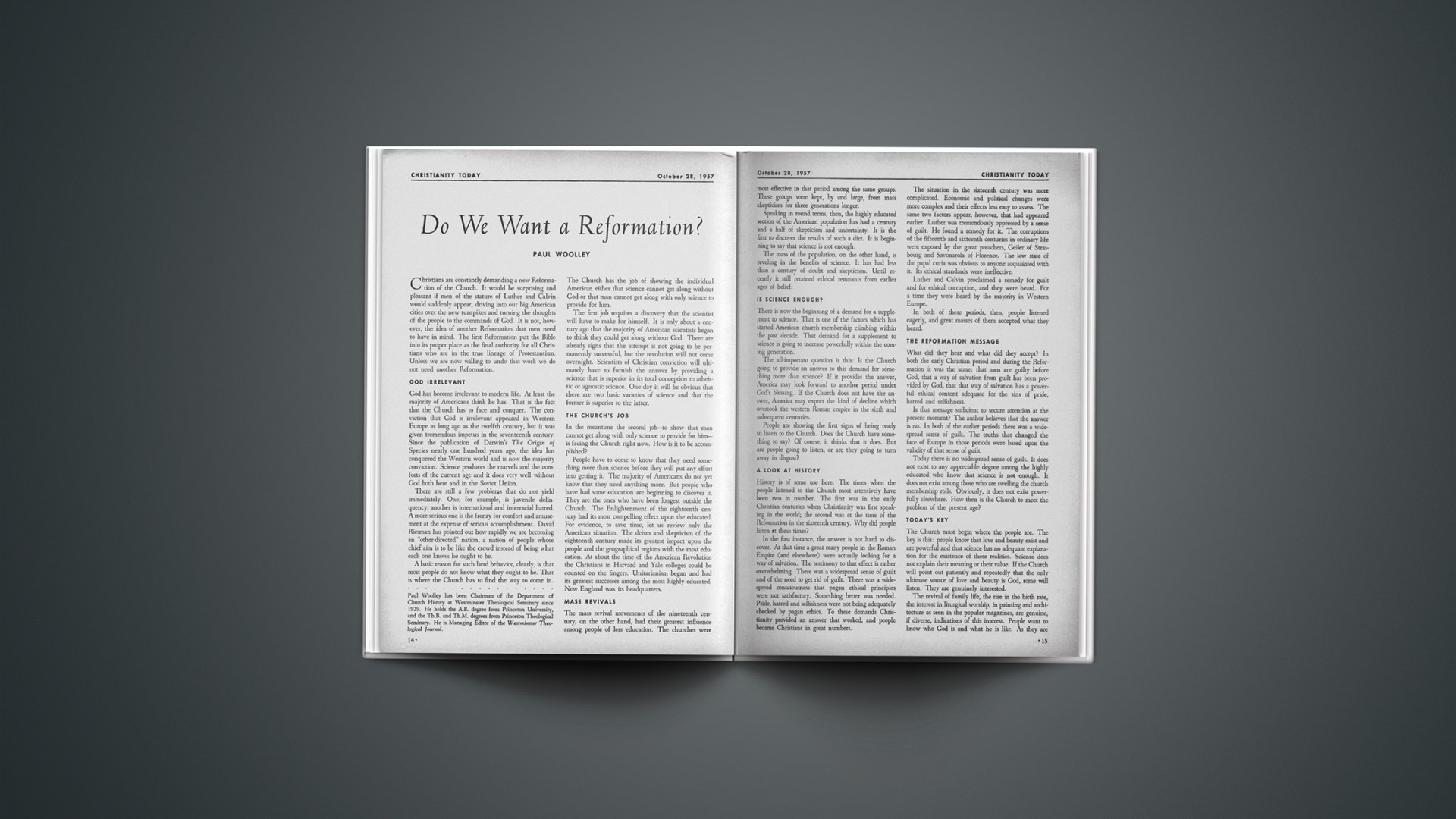Current Viewpoints
Contemporary Evangelical Thought, by Carl F. H. Henry, Ed., et al., Channel Press, New York. $5.00.
In this volume ten American scholars review the position of evangelical thought today in ten fields of study—the Old Testament, the New Testament, theology, ethics, apologetics, education, philosophy of history, philosophy of religion, science and religion, and evangelism and preaching. The editor points out in his preface that the writers have set two aims before them—to sketch the evangelical contribution to various fields of study, and also “to clarify present conservative thought on some of the crucial centers of Christian concern.”
It follows that the special interests and convictions of the writers find expression in their surveys; but this really adds to the value of their symposium. Thus Edward J. Young, who writes on the Old Testament, in commenting on the works of the Dutch scholar G. Ch. Aalders, confesses himself as sometimes “troubled by Aalders’ willingness to depart from traditional positions, particularly where such departure does not appear to be necessary.” No doubt, if this chapter had been written by Aalders or one of his pupils, a rather different emphasis might have appeared at this point. Again, those contributors who mention the redoubtable figure of Cornelius Van Til make it plain where they stand in relation to his challenging work; this is particularly true in the chapter entitled “Apologetics,” by Gordon H. Clark, in which we think we can detect the lingering echoes of a 13-year-old dispute. But this personal note is welcome; the writers are themselves involved in the issues with which they deal.
The editor himself writes the chapter on “Science and Religion”; one of the interesting features of this contribution is its shrewd evaluation of Bernard Ramm’s The Christian View of Science and Scripture—a volume which has created quite a stir throughout the English-speaking world.
To the reviewer, the chapters on the Old and New Testaments are of most immediate interest. Dr. Young pays generous tribute to the help which evangelical Old Testament students have received from the teaching of Cyrus H. Gordon and other Jewish scholars. On the other hand, he cannot agree that the modern revival of “biblical theology” among Christian scholars of the liberal wing represents a return to orthodoxy such as evangelicals could wholeheartedly welcome. This is an issue which deserves fuller discussion than the present review permits. Some readers may be surprised to find that the significance of the Qumran texts is not discussed under the Old Testament heading, but in Everett F. Harrison’s chapter on the New Testament. But this is as it should be, and Dr. Harrison’s discussion, though necessarily brief, is sound.
The writers pay attention to work that is being done in other English-speaking lands, and in the Netherlands, Germany and Scandinavia. The reviewer appreciates the tribute paid to the publications of the Inter-Varsity Fellowship, and as a Scot he is delighted to find John Macleod’s Scottish Theology worthily appraised.
The whole volume presents ample evidence of the vitality of evangelical scholarship today.
A few slips have been noted, especially in the initials of authors’ names. John Urquhart’s surname is regularly misspelt “Urquhardt”; and Dr. Graham Scroggie is (unfortunately) twenty years older than he is made out to be on p. 84.
F. F. BRUCE
Macartney Memoir
Salute Thy Soul, by Clarence E. Macartney, Abingdon, 1957. $2.00.
Asking a small-town preacher to review a book by Clarence E. Macartney is akin to asking the football coach of a small Junior High School what he thinks of Michigan State’s offensive pattern. What can he say? Here is the prince of American Presbyterian preachers whose pulpit abilities were tested and blessed in three significant pulpits, in the classroom and on the lecture podium.
Dr. Oswald T. Allis, Macartney’s seminary classmate and friend of many years, has acceded to a deathbed request to see this volume through the press. So that voice which many of us heard in Philadelphia and Pittsburgh, and which was silenced by death in 1957, continues to speak the eternal gospel of Jesus Christ.
“Salute Thy Soul,” the title of the first sermon as well as of the book, is, as the publishers claim, “Macartney at his best.” Starting from his usual biblical text, he probes the soul in definition, life experience and salvation. The stirring drama, rich illustration, warm evangelism are all here. Other striking sermons in this collection include, “The Soul’s Arabia,” “When Jacob Saw the Wagons” and “The Solitude of Sin.”
I would prefer to describe this volume as “A Collection of Thirteen Sermons on Biblical Texts” rather than try to force all the sermons into the subject of the first. It is difficult to see how the sermons on “What About Angels” and “The Mystery of Christ” fit into the suggested theme except in the broadest possible sense.
Dr. Macartney took to himself the last word he gave his brother Robertson, who was leaving his bedside to preach in a nearby church: “Put all the Bible you can into it.”
FRANK A. LAWRENCE
Botanical Answers
All the Plants of the Bible, by Winifred Walker, Harper. 1957. $4.95.
Winifred Walker, internationally known botanical artist, provides plant lovers with accurate paintings of 114 Bible plants (in full-page black-and-white reproduction) and a wealth of informative comment on the flowers, fruits, trees, shrubs, grains, herbs and vegetables mentioned in Scripture.
CARL F. H. HENRY
Physicians And Faith
Faith and Medicine, by Andre Schlemmer, Tyndale, London. 2s, 6d.
The Limits of Medical Responsibility, by Arnold S. Aldis, Tyndale, London. 6d.
An English surgeon and a French physician, both of them earnest Christians, have produced booklets which, while addressed primarily to members of their own profession, are not without interest and value for others. Mr. Aldis shows how introduction of the National Health Service in Great Britain, the unprecedented advances in the whole field of medicine in recent years, and the partial undermining of Christian faith and Christian ethics combine to necessitate a re-examination of medical responsibilities. For instance, the doctor’s responsibility to the state, which provides his remuneration, ought not to be in conflict with his primary responsibility to the individual patient. Christian doctors must maintain the highest standards, and keep abreast of medical progress and discovery, despite demands that record-keeping and form-filling make upon their time.
Dr. Schlemmer’s work covers more ground, giving clear scriptural teaching on “The Christian Life and the Body,” “Faith and the Care of the Body,” “Faith and Medical Science,” “Reverence for Life and Medical Vocation,” with a particularly useful final chapter on “Instinct, Reason, and Intuition.” Here and there one notes a remarkable identity of emphasis between the two booklets. “Knowledge alone is not enough,” says Mr. Aldis. “What we need is wisdom to use knowledge to the right ends. And wisdom depends not on cleverness, ingenuity, or technology; it depends on goodness and righteousness. This in its turn depends upon godliness and cannot long be divorced from it” (page 16). “It is necessary,” says Dr. Schlemmer, “for medical science to search, in addition to scientific knowledge, for wisdom, and to cultivate it” (page 57). And, like Mr. Aldis, he is convinced that this wisdom “must be derived from a source which is divinely given (i.e. God’s revelation) which is the guide and keeper of our reason as it pursues its search for wisdom.”
FRANK HOUGHTON
Sex And Marriage
The Intimate Life, by Norval Geldenhuys, Eerdmans. 96 pp., $1.50.
Described as “a practical, up-to-date handbook for engaged and newly married couples,” this little volume begins with a discussion of the Christian view of sex as a God-given good. It continues, to cover the importance of choosing the right life-partner, with special emphasis upon spiritual considerations. Then, following a frank chapter on the physical aspects of reproduction and coitus, the author treats of the mental and emotional attitudes that each partner to a marriage should develop towards the other in their life together.
Most of the remainder is devoted to birth-control from the standpoint of the fertile and sterile periods in a woman’s menstrual cycle. Elaborate charts and graphs accompany the clear presentation of this “natural” method of spacing children.
It is a good little book. Issued in a paperback edition, it would better suit ministers who are looking for something to give away.
G. AIKEN TAYLOR
Whitefield Distorted
George Whitefield, Wayfaring Witness, by Stuart C. Henry, Abingdon. $3.75.
It is regrettable that the first new book on Whitefield to appear in 30 years should leave the reader unable to decide whether the famous evangelist was a man of God or a cheap mountebank. Stating that “A strong case can be made for Whitefield as a devil or a saint” (p. 175), the author seems to feel that he fits somewhere between the two, but just where he does not know. The result is a hazy portrait, drawn in “warped perspective and untrue colour,” the very fault for which he criticizes Whitefield’s previous biographers (p. 175).
This failure to present a clear and true picture does not arise from a lack of source material. On the contrary, Dr. Henry, who is a professor at Southern Methodist University, has done an admirable job of preliminary research; he provides a bibliography of 186 entries and in the course of his text refers to his sources no less than 853 times. The difficulty lies rather in the deficient use of the material. The work of the true historian—the forming of an opinion only on the basis of amassing and analyzing all available evidence on any given phase of the subject—does not characterize this book, but almost every page produces some conclusion hurriedly drawn from fractional and often one-sided evidence; conflicting testimony is frequently ignored, and source material is referred to in a surface, prooftext fashion.
Scores of examples of this faulty practice might be cited. The author makes a case against Whitefield for his part in the “unconverted clergy” controversy in New England (p. 65), yet he completely ignores the extenuating circumstances which would force a revision of his judgment. The same is true of his charges concerning the extremes of emotion which characterized some phases of the revival (p. 64), and of his treatment of Whitefield’s attitude toward slavery. A full knowledge of the doctrinal controversy between Whitefield and Wesley is the sine qua non of understanding the man and his life, yet this book gives it but three fragmentary mentions (pp. 59, 79, 102). By the same process of snap judgment he accuses Whitefield of “an unbecoming pride of ignorance,” and “an arrogant hostility to learning” (p. 96); he stigmatizes him as “a theological cuttlefish” (p. 178), “an odd combination of humility and pride,” and one whose “success intoxicated him till his dying day” (p. 16). Statement after statement might thus be produced, containing the half truth and the untruth.
The book is most notable for what it leaves out. The wretched canards concocted by Unitarians, formalists, deists and atheists in their hatred of the man of God are introduced here, while the many testimonies to his goodness and greatness which came from a host of reliable witnesses among his contemporaries are almost all omitted. More than half of the book is given over to “The Message and How It Was Received,” yet amazing as it seems, that matchless effect of Whitefield’s preaching—the glorious conversion of thousands, and the resultant revival that transformed two nations—has no part in it. As a background to Whitefield’s life it must ever be borne in mind that he was in ill health and deeply in debt throughout almost all of his ministry, yet that is omitted too. There were many evidences of his regard for learning, his deep humility and his gracious love, but the reader looks in vain for them here. The passion to win souls and the fervor and warmth that were the main characteristics of his life, are nowhere found in this cold book. The author reveals no personal sympathy for Whitefield’s evangelicalism, as he reviews his theological position in a rather scoffing fashion.
In this reviewer’s opinion the work is but a sad caricature, which cannot fail to confuse the reader and bring reproach upon the memory of a holy, humble and mighty man of God.
ARNOLD A. DALLIMORE
Filing, Indexing Aid
Practical Study Methods for Student and Pastor, by Donald F. Rossin and Palmer Ruschke, D. F. Rossin Co., Minneapolis, 1956. $5.00.
Under a title that might mislead, here is a key to filing and indexing that makes an often complicated task appear simple. Thirty years’ experience, first in the pastorate and then in the production of filing aids, have given Donald F. Rossin a competence in this field that few could dispute. And the co-author, Palmer Ruschke, as a seminary student successfully adapted and promoted the materials and methods suggested in this book among seminary students and pastors. What we have here is not so much “study” methods as “filing and indexing” methods.
The author contends, and rightly so, that the pressures placed upon the minister today require him to use some sort of system of filing and indexing the materials he must use. It is just physically and mentally impossible to retain it all in one’s mind, and unless it is systematically filed, it is as good as lost. What minister would not warm to the idea of having more time for Bible study, auxiliary reading, family life, prayer and meditation, rest and recreation, service to his denomination and community? The authors make out a pretty convincing case for giving the minister this extra time if he will adopt the system detailed in this book.
First, they suggest a specially prepared loose-leaf pocket memo book that can be carried on one’s person at all times. Here can be kept a record of all addresses, appointments, sermon illustrations that occur to the pastor during the day, expense accounts, prospect lists, cards, etc. Then follows a chapter on the classification of materials read by the minister, using the Dewey decimal system. This is applied first to the storing of pamphlets, tracts, magazine articles, notes, etc., in a filing cabinet. The placement of tabs, use of colors and labeling are all explained. Then the Dewey system is applied to indexing what is read from one’s own library or the public sources. Thus the fruit of what one reads is not lost as memory fades.
The chapter on sermon mechanics is excellent and points the way both to systematic sermon preparation and preservation. Mr. Rossin has prepared a special series of cards and envelopes for use by ministers and explains how to use them. One of the unique features of this book is that the original owner of each copy has the privilege of writing to Minneapolis to receive free samples of the materials suggested. Then he can see for himself whether he and the system could work happily together.
As is to be expected, some suggestions will not meet every minister’s needs. For example, to have “five or ten ghost readers” reading periodicals and submitting reports on their reading gave the reviewer nightmares (p. 135). And he wonders, too, why 50 pages of a 175-page book had to be taken up with a large-print, double-spaced list of the Dewey decimal system classification numbers of every subject related to religion. This could have been easily compressed into one-third the space.
What about the poor harassed preacher who says he doesn’t even have time to get such a system started? This book has the answer. “Make it your hobby for a while.” Not a bad idea, if you don’t mind a hobby in your study.
J. C. HOLBROOK
Worthy Studies
The General Epistle of James, by R. V. G. Tasker, 7s.6d. and The Epistle of Paul to the Thessalonians, by Leon Morris, 7s.6d., Tyndale Press, London, 1956. Published in U.S.A. by Eerdmans, Grand Rapids. $2.00.
These two volumes are the first numbers to appear of a series of Tyndale New Testament commentaries. Based on the Authorized Version, they are primarily intended for the general Christian reader. They are, however, by no means facile or superficial, but seek to give within their modest compass a thorough exegesis of the books and proper attention to the principal questions of introduction, criticism and text as they arise. They are convenient in size, fitting the pocket (unless its capacity is unusually limited), well bound and attractively printed.
Professor Tasker of the University of London, who is general editor of the series, inaugurates it with a commentary which it is almost an impertinence to praise. He quotes a sermon where this letter was referred to as “a collection of sermon-notes,” and throughout Prof. Tasker’s book one hears the earnest, compelling tones of the preacher whose words are always springing direct from the sacred text. One is irresistibly reminded of John Calvin, who is, indeed, not infrequently quoted. Fair consideration is given to points where the interpretation is disputed and variant readings are treated with the judiciousness that one expects from an eminent textual critic. Prof. Tasker wears his learning lightly and his study is a treasure of its kind.
There are all too few commentaries on the Thessalonian epistles which are both good and moderate in size: so the contribution of Dr. Morris (who is Vice-Principal of Ridley College, Melbourne) is much needed. His commentary is a thoroughly competent, workmanlike affair. In his introduction he sets out the principal views of the origin and date of the epistles and argues convincingly for their authenticity and present order. Even if some detect some lack of economy in words and a certain informality of style in the commentary itself, none can deny (far more important) it is marked by fairness, insight and evangelical warmth.
The Tyndale New Testament commentaries have started auspiciously and one must look forward to future volumes.
A. F. WALLS
• CORRECTION—The review of Theodore O. Wedel’s book, The Pulpit Rediscovers Theology (September 30 issue), incorrectly stated that this book was issued by Westminster Press. It should have credited Seabury Press, Greenwich, Conn., as the publisher.—ED.



